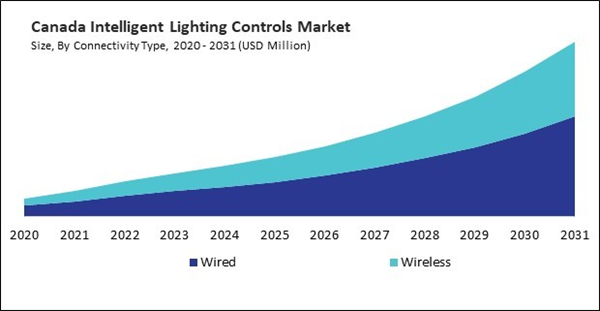The US market dominated the North America Intelligent Lighting Controls Market by Country in 2023, and would continue to be a dominant market till 2031; thereby, achieving a market value of $11.87 billion by 2031. The Canada market is experiencing a CAGR of 19.4% during (2024 - 2031). Additionally, The Mexico market would exhibit a CAGR of 18.3% during (2024 - 2031).
These lighting controls encompass various applications across various sectors, leveraging advanced technologies to enhance energy efficiency, improve user comfort, and optimize operational processes. These lighting controls are extensively used in commercial buildings to achieve energy savings and create comfortable environments for occupants. Lighting systems can be programmed to adjust automatically based on occupancy sensors and daylight harvesting. This reduces energy consumption during unoccupied periods and optimizes lighting levels to enhance productivity and comfort for workers.
Dynamic lighting scenes can be tailored to effectively showcase merchandise, attract customers, and create inviting atmospheres. Motion sensors and scheduling capabilities help conserve energy by adjusting lighting according to foot traffic and operating hours. Guest rooms and public areas benefit from these lighting controls that offer personalized settings for guests, enhance ambiance, and contribute to energy efficiency by dimming lights in unoccupied spaces.
Mexico is a major hub for automotive manufacturing, with numerous global automakers operating production facilities in the country. Integrating these lighting controls into automotive manufacturing plants and facilities is crucial for enhancing operational efficiency, worker safety, and energy management. These controls help optimize lighting conditions on assembly lines, inspection areas, and warehouses, contributing to overall productivity and quality control in vehicle production. As per the International Trade Administration (ITA), Mexico is the world’s seventh-largest passenger vehicle manufacturer, producing 3.5 million vehicles annually. Eighty-eight percent of vehicles produced in Mexico are exported, with 76 percent destined for the United States. Mexico is the world’s fifth-largest manufacturer of heavy-duty vehicles for cargo.The automotive manufacturing sector in Mexico faces increasing pressure to reduce operational costs and carbon emissions. Intelligent lighting controls offer energy-efficient solutions by incorporating LED lighting, motion sensors, and daylight harvesting features. These technologies help automotive plants in Mexico minimize energy consumption, lower electricity bills and comply with environmental regulations. Therefore, the rising adoption of Internet-connected smart home devices and the robust production of vehicles in the region fuel market growth.
Based on Connectivity Type, the market is segmented into Wired and Wireless. Based on Type, the market is segmented into Sensors, Ballast & LED Drivers, Microcontrollers, Dimmers & Switch Actuators, Transmitters & Receivers, and Others. Based on Application, the market is segmented into Smart Cities, Manufacturing, Automotive, Media & Entertainment, and Others. Based on countries, the market is segmented into U.S., Mexico, Canada, and Rest of North America.
List of Key Companies Profiled
- General Electric Company
- Cree, Inc. (SMART Global Holdings, Inc.)
- Honeywell International Inc.
- Eaton Corporation plc
- Cisco Systems, Inc.
- Siemens AG
- Acuity Brands, Inc.
- ams-OSRAM AG
- Signify N.V.
- Panasonic Holdings Corporation
Market Report Segmentation
By Connectivity Type- Wired
- Wireless
- Sensors
- Ballast & LED Drivers
- Microcontrollers
- Dimmers & Switch Actuators
- Transmitters & Receivers
- Others
- Smart Cities
- Manufacturing
- Automotive
- Media & Entertainment
- Others
- US
- Canada
- Mexico
- Rest of North America
Table of Contents
Companies Mentioned
- General Electric Company
- Cree, Inc. (SMART Global Holdings, Inc.)
- Honeywell International Inc.
- Eaton Corporation plc
- Cisco Systems, Inc.
- Siemens AG
- Acuity Brands, Inc.
- ams-OSRAM AG
- Signify N.V.
- Panasonic Holdings Corporation









